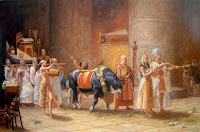
When the ancient Egyptians sacrificed a bull, they invoked upon its head all the evils that might otherwise befall themselves and the land of Egypt, and thereupon they either sold the bull's head to the Greeks or cast it into the river.
While reading Ovid's Metamorpheses, it is unquestionable that the "bovine" plays a central role. Professor Sexson mentioned this in class and I decided to research the myth behind the bovine. I had found quite a bit and realized that there was a theme. In Egyptian mythology, a bull-deity called Apis, was said to be a life-force and also a symbol of the Pharaoh. They believed that Apis had reincarnated into a real bull. Bovines that had special markings were taken to a temple and given a harem of cows. If the bull had a white triangle on its black forhead, the outline of a white vulture wing along its back, the mark of a scarab under its tongue, a crescent shape on its right flank, and double hairs on its tail. Then it would be considered a cow worthy of worship. Kinda picky.
 Even in Paleolithic European cave paintings Aurochs (ancestors of domestic cattle) are depicted. According to some their life force had magical traits. In India the cow is viewed a bountifully sacred animal. Not only is the animal spared but it is allowed the right of way over traffic. While we may slap a cow in between two buns, other cultures have found the bovine as a useful way of worship.
Even in Paleolithic European cave paintings Aurochs (ancestors of domestic cattle) are depicted. According to some their life force had magical traits. In India the cow is viewed a bountifully sacred animal. Not only is the animal spared but it is allowed the right of way over traffic. While we may slap a cow in between two buns, other cultures have found the bovine as a useful way of worship.
No comments:
Post a Comment